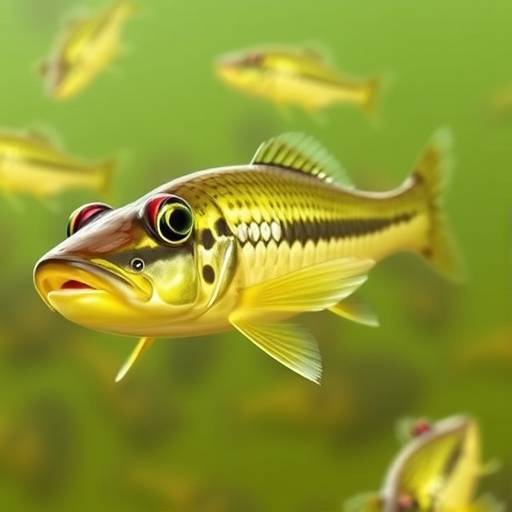In an unprecedented stride toward enhancing aquaculture practices, researchers from various institutions have successfully developed a 100 K single nucleotide polymorphism (SNP) array specifically designed for the small yellow croaker, a vital fish species in coastal regions of East Asia. This groundbreaking innovation promises to revolutionize the future of genomic selection in aquaculture, particularly regarding traits that significantly contribute to the growth and disease resistance of this economically important species.
The small yellow croaker, known scientifically as Larimichthys polyactis, holds immense value in commercial fisheries and aquaculture. This fish has been a staple in traditional Asian cuisines and is a key component of the region’s seafood markets. However, the increased demand coupled with environmental changes and disease outbreaks has necessitated the development of advanced breeding strategies to ensure sustainable production levels. This challenge leads to the innovative work conducted by Liu, Wang, Ye, and their colleagues, who have embarked on creating a robust genetic tool to facilitate this process.
Understanding the genetic architecture of the small yellow croaker is crucial for implementing effective breeding programs. Traditional selective breeding methods can yield progressive results but are often slow and imprecise, particularly when dealing with complex traits influenced by multiple genes. The SNP array developed by the researchers serves as a game-changer by allowing for the identification of genetic markers linked to favorable traits, accelerating the breeding process while enhancing precision.
The SNP array consists of 100,000 genetic markers that provide comprehensive coverage of the small yellow croaker genome. This high-density linkage map enables researchers to carry out genome-wide association studies (GWAS) with unprecedented resolution. By associating specific SNPs with traits such as growth rate and disease resistance, breeders can make informed decisions and select individuals that not only exhibit superior performance but also contribute to the genetic diversity necessary for long-term sustainability.
One of the most significant challenges facing aquaculture today is the impact of diseases. As fish farming expands, so does the potential for viral and bacterial outbreaks. These health issues can devastate fish populations and economic viability. The SNP array offers a promising solution by providing a clearer understanding of the genetic basis underlying resistance to prevalent diseases. This knowledge empowers breeders to select for resilient stocks, thereby reducing the likelihood of disease spread and enhancing overall productivity in aquaculture systems.
The applications of this SNP array extend beyond mere selection for growth and disease resistance. Its implementation paves the way for more comprehensive studies into other economically important traits such as feed efficiency, environmental adaptability, and reproductive performance. By integrating these traits into breeding programs, aquaculture producers can create superior lines of fish that are better suited for changing environmental conditions and consumer demands.
In addition to its practical applications in breeding, the SNP array is also a crucial asset for fundamental research into the small yellow croaker’s biology. Understanding the genetic basis of various traits not only aids in selective breeding but also informs broader ecological studies, including species conservation efforts and the impacts of climate change on marine populations. The genetic resources revealed through this research can thus serve as a foundation for future work in aquatic genomics.
The development of this SNP array represents a significant achievement in collaboration among geneticists, breeders, and aquaculture specialists. Such multidisciplinary efforts are essential for addressing the complexities of aquaculture genetics. The synthesis of knowledge and technology creates a synergistic effect that enhances the potential for innovations that meet global food production challenges.
Moreover, the implications of this research extend beyond the small yellow croaker alone. The methodologies and insights gained from this study could be applied to other fish species, further broadening the scope of the benefits realized through genomic selection. By establishing a framework for SNP array development, researchers set a precedent that can influence the future of aquaculture genetics worldwide.
The release of the SNP array is particularly timely, as global fish consumption continues to rise, and the strain on wild fish stocks becomes untenable. With a growing population reliant on fish as a primary protein source, advancements in breeding technologies will play a critical role in ensuring food security. As aquaculture evolves, the integration of genomic tools like the SNP array enables producers to navigate the complexities of fish breeding efficiently.
As the research team prepares for the practical applications of their findings, the excitement surrounding this technological advancement reverberates throughout the scientific community and the aquaculture industry. The drive toward a more sustainable and productive aquaculture sector gains momentum as stakeholders recognize the potential of using genetics as a foundation for future developments.
In conclusion, the introduction of the 100 K SNP array for the small yellow croaker marks a remarkable advancement in aquaculture genetics, presenting numerous opportunities for improving growth, disease resistance, and overall fish farming efficiency. This innovation not only contributes to the sustainability of a critical aquatic species but also establishes a pathway for future research and application in the broader scope of fish genomics.
As initiatives like these continue to unfold, the global aquaculture community stands poised to harness the power of genetic research, ultimately transforming fish farming practices and securing the future of food production for generations to come.
Subject of Research: Development of a SNP array for small yellow croaker and its applications in genomic selection.
Article Title: First development of a 100 K SNP array for small yellow croaker and its application in genomic selection for growth and disease resistance.
Article References: Liu, F., Wang, R., Ye, T. et al. First development of a 100 K SNP array for small yellow croaker and its application in genomic selection for growth and disease resistance. BMC Genomics (2025). https://doi.org/10.1186/s12864-025-12343-w
Image Credits: AI Generated
DOI:
Keywords: SNP array, small yellow croaker, genomic selection, growth, disease resistance, aquaculture, genetics, fish breeding.




